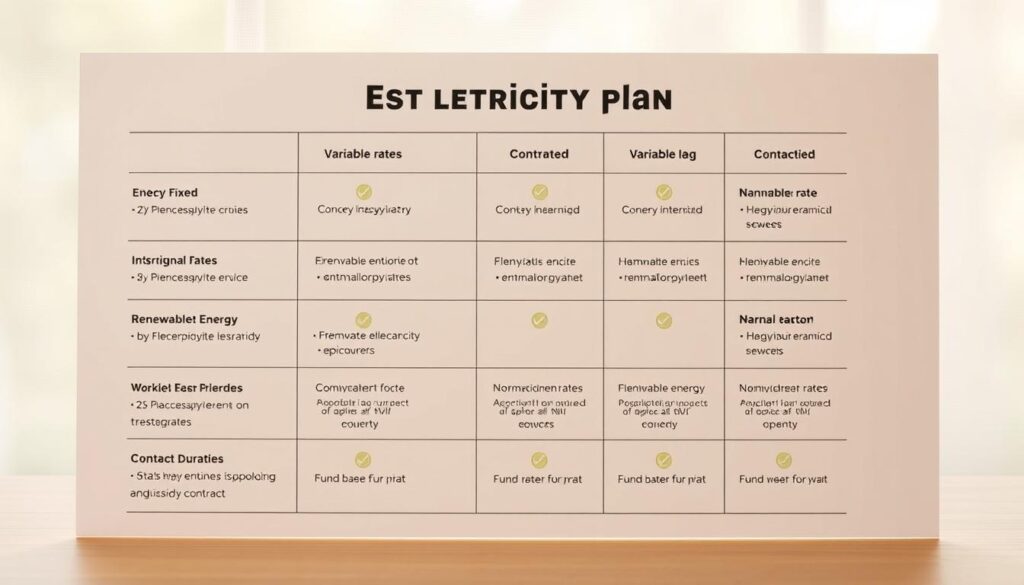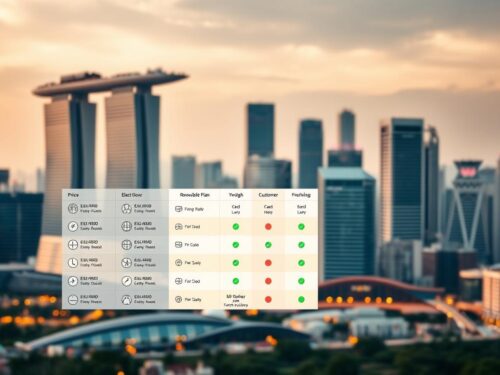Singapore’s energy market has changed dramatically in recent years. Consumers now have real choices when it comes to their power supply. This competitive landscape means better deals and more options for households.
Many residents can save money by switching from traditional services to competitive retailers. Understanding different plan types can lead to significant monthly savings on your bills.
This comprehensive guide compares all major providers and their offerings. We’ll help you find the right plan for your needs and budget.
Our comparison uses a standard 4-room HDB flat as a reference point. All prices and promotions are current as of early 2025 but may change.
Key Takeaways
- Singapore’s electricity market offers multiple provider options
- Switching from SP Services can lead to cost savings
- Different plan types suit different household needs
- Prices and promotions change regularly
- Consider both rates and additional features when choosing
- Use standardized comparisons for accurate cost analysis
Understanding Singapore’s Open Electricity Market (OEM)
Singapore’s power landscape underwent a revolutionary transformation with the introduction of the Open Electricity Market. This initiative fundamentally changed how households access and pay for their energy needs.
The Energy Market Authority launched this groundbreaking program in October 2017. Their goal was to create competition and choice where none existed before.
By May 2019, every household gained the freedom to select their preferred supplier. This marked a significant shift from the previous single-provider system.
What is the OEM and Why Does It Matter?
The Open Electricity Market represents Singapore’s commitment to energy liberalization. It introduced competitive pricing and diverse options for consumers.
Before this change, residents had limited choices for their power supply. The market opening created opportunities for savings and tailored services.
Competition drives innovation and better value. Six main retailers now operate alongside the traditional provider:
- Geneco
- Keppel Electric
- PacificLight Energy
- Sembcorp Power
- Senoko Energy
- Tuas Power Supply
This variety means you can find plans that match your specific usage patterns and budget.
Your Current Provider: SP Services and the Regulated Tariff
SP Services remains the default option for households that haven’t switched. They continue providing reliable service under the regulated tariff system.
The regulated tariff gets reviewed every three months. It reflects actual power generation costs and market conditions.
Currently, the rate stands at 31.72¢ per kWh including GST for Q4 2024. This rate serves as the benchmark against which other plans get measured.
Even if you choose another retailer, SP Services maintains the power grid and handles billing. Your physical connection and service reliability remain unchanged.
The relationship between the regulated tariff and retailer pricing creates interesting dynamics. Many providers offer discounts against this benchmark rate.
Understanding this system helps you make informed decisions about your energy choices.
Types of Electricity Plans Available
Singapore’s competitive energy market offers several distinct plan structures. Each option serves different household needs and risk preferences.
Understanding these variations helps you make smarter choices about your power consumption. The right selection can lead to substantial savings over time.

Fixed Price Plans: Locking in Your Rate
Fixed price plans provide complete price stability throughout your agreement period. Your rate remains constant regardless of market fluctuations.
This protection shields you from quarterly increases in the regulated tariff. Many households prefer this predictability for budgeting purposes.
Typical contract lengths range from 6 to 24 months. Longer agreements often feature more attractive locked rates.
Popular fixed price options currently include:
- Geneco’s 24-month fixed rate plan
- Tuas Power’s 12-month stable pricing option
- Senoko Energy’s 6-month short-term fixed plan
Discount Off Regulated Tariff (DORT) Plans: A Percentage-Based Discount
DORT plans offer a straightforward discount percentage off the prevailing regulated tariff. You always pay less than the standard rate.
The mathematics are simple: if the tariff is 31.72¢ per kWh and you have a 3% discount, you pay 30.77¢. This guarantees savings regardless of tariff movements.
PacificLight currently offers the only DORT plan available. Their offering includes 3% off the regulated tariff plus an additional 5% prompt payment discount.
This plan type automatically adjusts with tariff reviews. You benefit from both low rates and potential future decreases.
Non-Standard Plans: Peak/Off-Peak and Wholesale Options
Innovative plan structures cater to specific consumption patterns. These options can maximize savings for the right households.
Peak/off-peak plans feature different rates for daytime and nighttime usage. They ideal for families who primarily use power during off-peak hours.
Wholesale market plans reflect real-time pricing that changes every 30 minutes. These offer potential savings but carry volatility risks.
Consider these non-standard options if your usage patterns are unusual or flexible. They require more active management but can yield significant rewards.
| Plan Type | Price Stability | Ideal For | Contract Length | Risk Level |
|---|---|---|---|---|
| Fixed Price | High | Budget-conscious households | 6-24 months | Low |
| DORT | Medium | Those wanting guaranteed savings | 12 months | Medium |
| Peak/Off-Peak | Variable | Night-shift workers | 12-24 months | Medium |
| Wholesale | Low | Energy-savvy consumers | 1 month | High |
Each plan type serves different financial goals and risk tolerances. Consider your household’s usage patterns before committing to any agreement.
Review all terms carefully, especially regarding early termination fees and rate changes. The right choice depends on your specific circumstances and comfort with price variability.
Finding the Best Electricity Provider in Singapore: A Detailed Comparison
Now that you understand the different plan types, let’s examine the major retailers. Each company brings unique advantages to the table.
This detailed comparison helps you identify which supplier matches your household needs. Consider both pricing and additional benefits when making your choice.

Geneco: Price Match Guarantee and Competitive Rates
Geneco stands out with its innovative price protection feature. They offer fixed plans at 28.87¢ per kwh for 12-24 month contracts.
Their unique selling point is the price match guarantee. If you find a better rate elsewhere, they’ll match it.
This commitment ensures you always get competitive price points. Their customer service receives consistently positive reviews.
Tuas Power Supply: Grocery Vouchers and Consolidated Billing
Tuas power attracts customers with valuable grocery vouchers. New sign-ups receive $100-160 in supermarket credits.
They also offer consolidated billing through SP Services. This means one combined bill for both your grid usage and power supply.
The convenience factor makes them popular among busy families. Their fixed-rate plans provide budgeting certainty.
PacificLight Energy: Diverse Plan Lengths and Options
PacificLight offers the most flexible contract terms available. They have options ranging from 12 to 36 months.
Their 36-month fixed plan locks in at 28.44¢ per kwh. This represents exceptional long-term value.
They also provide no-contract options for maximum flexibility. This electricity retailer truly caters to diverse needs.
Senoko Energy: Renewable Energy and Smart Rewards
Senoko energy integrates sustainability into all their offerings. Every plan includes renewable energy components.
Their Smart Rewards program gives points for timely payment. These points convert to valuable rebates on future bills.
This dual approach of green energy and customer incentives makes them stand out. Their rebate system rewards loyal customers.
Keppel Electric: Eco-Friendly Options and Promotions
Keppel Electric emphasizes environmental responsibility. They offer carbon-neutral options for eco-conscious households.
Current promotions include a free Microgreen Kit with sign-up. This adds tangible value beyond just power supply.
Their fixed rates remain competitive while supporting sustainability initiatives. They balance cost with environmental values.
Sembcorp Power: 100% Green Energy Plans
Sembcorp Power commits fully to renewable energy solutions. All their plans feature 100% green energy sources.
They provide 50kWh of green energy supply each month. This demonstrates their environmental dedication.
While their price points might be slightly higher, the eco-benefits justify the premium for many customers.
| Retailer | Key Feature | Contract Length | Rate (¢/kWh) | Special Offer |
|---|---|---|---|---|
| Geneco | Price Match Guarantee | 12-24 months | 28.87 | Guaranteed best rate |
| Tuas Power | Consolidated Billing | 12-24 months | 29.10 | $100-160 grocery vouchers |
| PacificLight | Flexible Terms | 12-36 months | 28.44 | No-contract option |
| Senoko Energy | Smart Rewards | 12-24 months | 29.05 | Loyalty points system |
| Keppel Electric | Eco-Friendly | 12-24 months | 29.20 | Free Microgreen Kit |
| Sembcorp Power | 100% Green Energy | 12-24 months | 29.50 | 50kWh green energy/month |
Each retailer brings distinct advantages to the market. Your ideal choice depends on what you value most: lowest price, green energy, or additional perks.
Consider your average consumption per month when comparing these options. The right supplier can significantly reduce your energy bill while meeting your specific needs.
How Much Will You Really Save? Cost Analysis for a 4-Room HDB
Numbers tell the real story when comparing power options. Let’s examine actual savings using a standard 4-room flat as our benchmark.
This analysis uses average consumption data to create fair comparisons. You’ll see exactly how different choices affect your wallet.

Breaking Down the Estimated Monthly Bills
The average 4-room HDB uses about 365 kwh each month. This creates a consistent baseline for our calculations.
SP Services charges 31.72¢ per kwh under the regulated tariff. That equals $111.87 per month before any discounts.
Competitive retailers offer significantly better rate structures. Here’s how they compare:
- Geneco 24-month fixed plan: $105.38 monthly
- PacificLight 36-month option: $103.80 per month
- Senoko Energy 12-month agreement: $105.38 on your bill
- Tuas Power 24-month contract: $105.38 each month
These savings add up quickly over time. Even small differences create meaningful annual reductions.
The Impact of Contract Length on Your Savings
Longer commitments typically mean better price points. Providers reward customers who sign extended agreements.
PacificLight’s 36-month plan offers the lowest rate at 28.44¢ per kwh. This creates the maximum saving potential.
Shorter contracts provide more flexibility but slightly higher costs. The 12-month plan from Senoko still beats the regulated tariff.
Consider your household’s stability when choosing contract length. Longer months mean better rates but less adaptability.
| Provider | Contract Length | Monthly Cost | Annual Savings |
|---|---|---|---|
| SP Services | No contract | $111.87 | Baseline |
| PacificLight | 36 months | $103.80 | $96.84 |
| Geneco | 24 months | $105.38 | $77.88 |
| Senoko Energy | 12 months | $105.38 | $77.88 |
Your actual bill depends on precise consumption patterns. These numbers represent averages for typical usage.
Some providers offer additional rebates for prompt payment or loyalty. These can further reduce your final costs.
Remember that GST affects all electricity purchases equally. The 9% tax applies regardless of your chosen retailer.
“The longest contracts deliver the best value, but choose terms that match your life situation.”
Evaluate your family’s needs before committing. The right balance between savings and flexibility depends on your circumstances.
Beyond the Rate: Promotions, Rebates, and Unique Features
The true value of your power plan extends far beyond the basic rate per kWh. Smart consumers know that additional perks and hidden details can make a substantial difference in your overall expenses.
Many retailers offer creative ways to reduce your monthly costs through various incentives. Understanding these extras helps you maximize your savings potential.
Leveraging Credit Card Promotions for Extra Savings
Your choice of payment method can unlock additional discounts on your power bills. Several banks partner with retailers to offer special credit card promotions.
Citi cards currently provide $20 rebates for new sign-ups. UOB cardholders can enjoy $30 in savings when they switch.
HSBC offers the most generous promotion with up to $120 in rebates. These offers typically require using your card for recurring bill payments.
Always check the eligibility requirements before applying. Some promotions have minimum spending thresholds or specific application dates.
Referral Programs and Sign-Up Bonuses
Many companies reward customers who bring friends and family to their service. These referral programs can put extra money in your pocket.
Most retailers offer $20-40 for each successful referral. The person you refer usually receives a similar welcome bonus.
This creates a win-win situation for both parties. Some companies even provide higher rewards for multiple referrals within a specific period.
These programs represent an easy way to offset your monthly costs. Just make sure your friends actually want to switch before referring them.
Understanding the Fine Print: Fees and Terms & Conditions
Always read the complete terms conditions before signing any agreement. Hidden fees can quickly erase your apparent savings.
Watch for early termination charges that can reach $200 with some companies. Tuas Power specifically charges this amount for contract cancellation.
Other potential fees include administrative charges, late payment penalties, and paper bill fees. Some retailers require security deposits for certain customers.
Transmission loss factors might affect your final bill amount. This technical charge accounts for energy lost during delivery.
Carbon tax and AMI meter installation fees could also apply in some situations. Auto-renewal clauses might lock you into unfavorable terms if you forget your contract end date.
“The smallest print often contains the most important details about your agreement.”
Strategic payment method selection can help you avoid many of these charges. Setting up automatic payments prevents late fees and often qualifies you for additional discounts.
Digital billing typically avoids paper statement charges. Understanding these details helps you get fixed savings without surprises.
| Fee Type | Typical Cost | How to Avoid |
|---|---|---|
| Early Termination | $50-200 | Choose shorter contracts or no-contract plans |
| Late Payment | $10-30 | Set up automatic payments |
| Paper Bills | $2-5 monthly | Opt for digital statements |
| Security Deposit | 1-2 months’ bill | Maintain good payment history |
Always ask about current promotions when discussing options with retailers. Many have unadvertised deals that can provide additional value.
The right combination of rate, rebates, and payment strategies can significantly reduce your energy expenses. Take time to understand all aspects before making your final decision.
How to Switch Your Electricity Provider
Making the switch to a new power supplier is simpler than many people realize. The process is designed to be smooth and hassle-free for households.
You’ll enjoy the same reliable service throughout the transition. Your lights won’t flicker during the changeover period.

Most switches complete within about one week from start to finish. This quick timeline means you can start saving almost immediately.
A Step-by-Step Guide to a Seamless Transition
Begin by comparing different plans from various retailers. Look at both the price per kWh and any additional benefits.
Once you select your preferred option, complete the online application. You’ll need some basic information handy during this process.
The new company handles all the paperwork behind the scenes. They coordinate with SP Group to make the switch happen smoothly.
You’ll receive confirmation of your switch completion date. Mark this on your calendar for future reference.
Your first bill from the new supplier will arrive shortly after. Compare it to your previous statements to verify your savings.
What to Consider Before You Sign a Contract
Think carefully about how long you want to commit to a particular plan. Contract lengths typically range from 6 to 36 months.
Longer agreements often feature better rate structures. But they also mean less flexibility if your situation changes.
Always review the early termination fee details before signing. Some companies charge significant penalties for cancelling early.
Check the auto-renewal terms in your agreement. Many contracts automatically extend if you don’t cancel before the end date.
Consider your preferred payment method when choosing a retailer. Some offer extra discount for automatic bank deductions.
Look into current promo offers that might apply to your situation. These temporary benefits can add substantial value.
“The smoothest transitions happen when you understand all contract details before committing.”
Verify that your new plan works with any existing solar installations or special arrangements. Most standard households won’t face compatibility issues.
After switching, monitor your first few bills carefully. Ensure the promised price matches what appears on your statements.
Remember that you can always switch again when your current contract ends. The market continues to evolve with new offers regularly.
Conclusion: Choosing the Right Plan for Your Home
Finding your ideal power plan involves balancing several factors. Consider your household’s unique usage patterns and budget goals.
Switching can save $6-8 monthly for 4-room HDBs. Compare both rates and extra features like green energy options.
Use the official OEM comparison tool. It estimates bills based on your residence type and consumption.
Check terms conditions carefully before signing any contract. Look for hidden fees and auto-renewal clauses.
Regular market monitoring ensures you always get competitive price plans. Revisit your choice annually to maximize savings.



